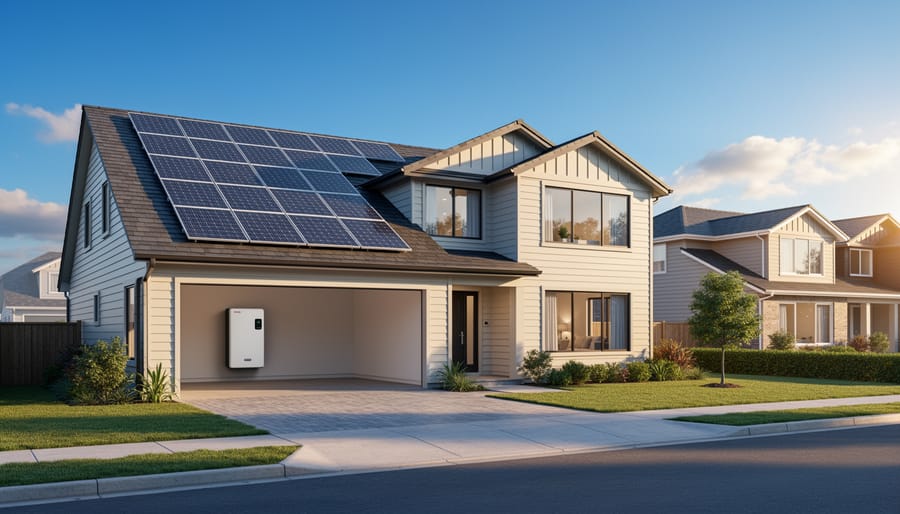4 Best Solar Combiner Boxes in 2023
Updated:

The best solar combiner boxes will endure extreme temperatures, absorb lightning strikes, and resist rain, all to combine your solar panels into one surge-protected line, straight to your electronics bay.
So, when going through your options for a solar combiner box, ensure you look out for safety features. But apart from that, you should consider capacity, the number of input strings, operating temperature, and weather resistance.
Things to Consider
Top solar combiner boxes typically come with multiple safety features, such as disconnect switches, circuit breakers/fuses, surge protectors, and lightning arrestors.
These features stop the flow of current when there is a surge, a short circuit, an arc fault, or similar electrical faults. Then, the lightning arrestor is there to protect the solar power system from possible damage by a lightning strike.
As with many other solar devices, PV combiner boxes have varying capacities. The capacity of a PV combiner box is typified by the input voltage, output voltage, and total DC output. The higher the capacity of combiner boxes, the more power they can handle.
Generally, a combiner box can have at least 3 strings and as many as 52 strings. What determines the option you opt for is the number of solar panel strings in your panel system.
The operating or working temperature of a combiner box is also essential. Combiner boxes operate optimally within specified ranges. Using your box outside the range specified by the manufacturer will cause a drop in effectiveness and reduce lifespan.
In most cases, a combiner box will be installed outdoors. So, it will be exposed to the elements, especially water. For this reason, your combiner box must come with a weather-resistant (waterproof) enclosure, else it goes bad or becomes a shock hazard.
Best Solar Combiner Box at a Glance
- Best Overall: ECO-WORTHY 6 String PV Combiner Box
- Best High-Voltage Capacity: ECO LLC 4 String PV Combiner Box
- Best Water Resistance: ENZPOWER IP66 Solar System Box
- Best High Input Voltage per Array: AIMS Power COM3IN60A Solar Array Combiner
Best Solar Combiner Boxes Reviewed
1. ECO-WORTHY 6 String Combiner Box

The Eco-Worthy 6 String Combiner Box ranks at the summit of our list of the best solar combiner boxes. This is not surprising because it has the highest number of string inputs, the most extensive operating temperatures, and one of the highest capacities.
The Eco-Worthy Box is crafted for 6 strings, the highest on the list. No other combiner box comes close to it.
Beyond the number of strings, the Eco-Worthy Box can operate at temperatures between -30 and +70 degrees Celsius. No other combiner box on the list comes close to it. Now, while the operating temperature of the Eco-Worthy Combiner Box is extensive, you should still avoid exposing it to extreme temperatures. To this end, install it on a north-facing wall. This way, it will not be exposed to the sun for too long.
When it comes to capacity, the Eco-Worthy 6-String Box is pretty impressive. It supports a maximum of 10 amps for each PV array and offers a maximum DC output of 60 amps. Only the AIMS COM3IN60A matches this current output. The maximum input voltage supported by the Eco-Worthy 6 String Box is 250 volts – the same as the maximum output voltage supported. Only matched by the ECO LLC 4 String Box.
When it comes to safety, the Eco-Worthy 6 String Box still impresses. For one, it is a non-conductive box, so there is no risk of electric shock by touching it. Then again, it is packed with anti-backflow diodes and circuit breakers. There is also the lightning and surge protector module with a 1000-volt rating. Only the ECO LLC 4 String Box matches this level of safety.
The ECO LLC 4 String Box enclosure has an ingress protection code of IP65. So, it will resist water from normal rain and is dust-tight.
Installing the Eco-Worthy 6-String Box is pretty easy. However, the wiring could be thicker.
Pros
- It supports the highest number of strings among the boxes on the list.
- It offers the highest input and output current capacity of any combiner box on the list.
- The operation temperature of this combiner box is the most extensive on the list.
- It is water-resistant with an IP65 rating – only bettered by the ENZPOWER IP66 Solar System Solar Box.
- The Eco-Worthy 6 String Box features multiple safety components.
- It is quite easy to install.
Cons
- The wiring could be thicker to support the power output better.
2. ECO LLC 4 String PV Combiner Box
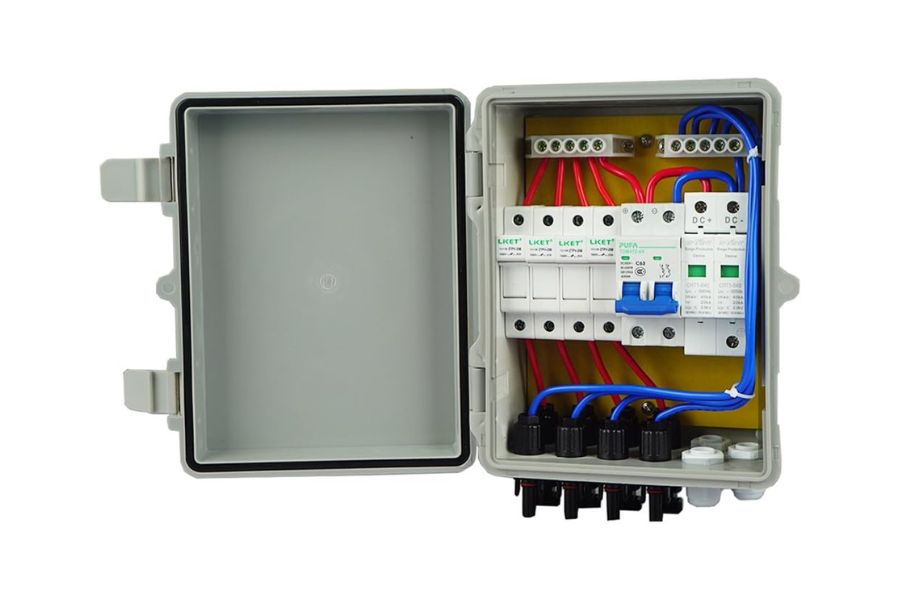
The ECO LLC 4 String Box comes in second best on our list. Apart from the Eco-Worthy 6 String Box, it offers more string inputs, high safety levels, and better voltage capacity than other combiner boxes on the list.
As the name says, the ECO LLC 4 String Box is crafted for 4 strings. The only combiner box with more is the Eco-Worthy 6 String Box.
The capacity of the ECO LLC 4 String Box is also impressive. While it is not on the Eco-Worthy 6 String Box level, it does pack a punch. For each array, it supports a maximum current of 10 amps. So, it supports up to 40 amps of maximum DC output. Only the Eco-Worthy 6 String Box and the AIMS Power COM3IN60A surpass this.
The ECO LLC 4 String Box can take a maximum input and maximum output voltage of up to 250 volts. This is on par with the Eco-Worthy Box, but more than what the AIMS COM3IN60A offers.
On safety, the ECO LLC Box matches the Eco-Worthy Box. Both combiner boxes are touch-safe since they are non-conductive. They both come with anti-backflow diodes to keep power from flowing back to the panels from the battery. Then again, both combiner boxes have high-voltage fuses for overvoltage, overcharge, and overcurrent protection.
Like the Eco-Worthy Box, the ECO LLC Box also comes with a surge/lightning arrestor module with a 1000-v rating. So, you would not have to worry about damage by lightning or sudden power increase.
Fitting the ECO LLC Box is pretty straightforward. And while it offers some resistance to the elements, you had better mount it in a place with minimal or no rain/water or sun exposure.
Pros
- The maximum input and output voltage are remarkable – on par with the Eco-Worthy Box.
- The maximum DC output is decent – but not as high as Eco-Worthy Box and AIMS Power COM3IN60A.
- It supports up to 4 strings – the second-highest of any combiner box on the list.
- It comes with many safety features – similar to the Eco-Worthy Box.
Cons
- It is not very weatherproof; you may have to conceal it so it can last longer.
3. ENZPOWER IP66 Solar System Box
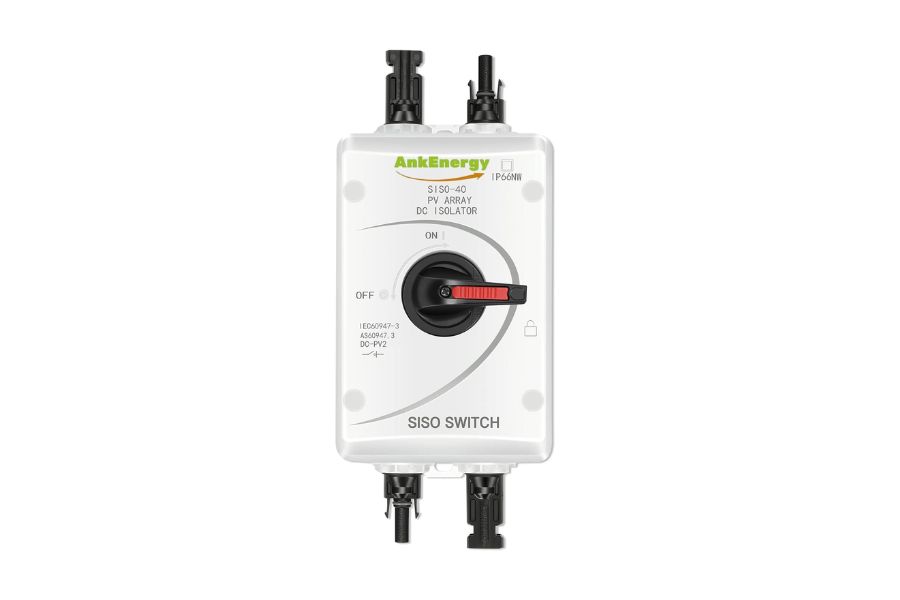
With the ENZPOWER IP66 Solar System Box, you get a host of top-notch features. But this combiner box’s water resistance stands out the most among all those features.
The ENZPOWER IP66 Solar System Box is made with an enclosure rated IP66. This is the highest level of water resistance we have on this list. Only the Eco-Worthy Box and the AIMS COM3IN60A close with their IP65 rating. While the Eco-Worthy Box and the AIMS COM3IN60A can withstand water jets, the ENZPOWER IP66 Solar System Box can resist stronger water jets. So, it will do better in heavier rain than the other combiner boxes.
Apart from its water resistance, the ENZPOWER IP66 Solar System Box is packed with safety features. One such feature is the disconnect switches, which stop the current flow in case of circuit abnormalities. The load-breaking component also facilitates the solar lighting system’s breaking, on-load making, and safe disconnection.
While the safety features stated above are decent, they do not quite match the level of safety of the Eco-Worthy Box and the ECO LLC 4 Box.
The ENZPOWER IP66 Solar System Box is crafted for one string. This falls quite short of the Eco-Worthy and ECO LLC 4 Box. Then, its maximum DC output is around 32 amps. The Eco-Worthy Box and the ECO LLC 4 Box trump this with 60 amps and 40 amps, respectively.
While the Eco-Worthy Box has the most impressive operating temperature (-30 to 70 degrees Celsius), the ENZPOWER IP66 Solar System Box is not far off. It operates between -5 and 60 degrees Celsius – the second-highest on the list.
All in all, the ENZPOWER IP66 Solar System Box is great for an off-grid system. It is lightweight – weighing just 1.73 pounds, compact, and easy to install.
Pros
- It offers the highest water resistance of any combiner box on the list.
- It is pretty safe – although the Eco-Worthy Box and the ECO LLC 4 Box have more safety components.
- The maximum DC output is considerable but below those of the Eco-Worthy Box and the ECO LLC 4 Box.
- It is easy to install.
- It is lightweight and compact.
- The operating temperature range is pretty okay – only bettered by the Eco-Worthy Box.
Cons
- It supports just one string – unlike the Eco-Worthy Box, which can support up to 6.
4. AIMS Power COM3IN60A Solar Array Combiner
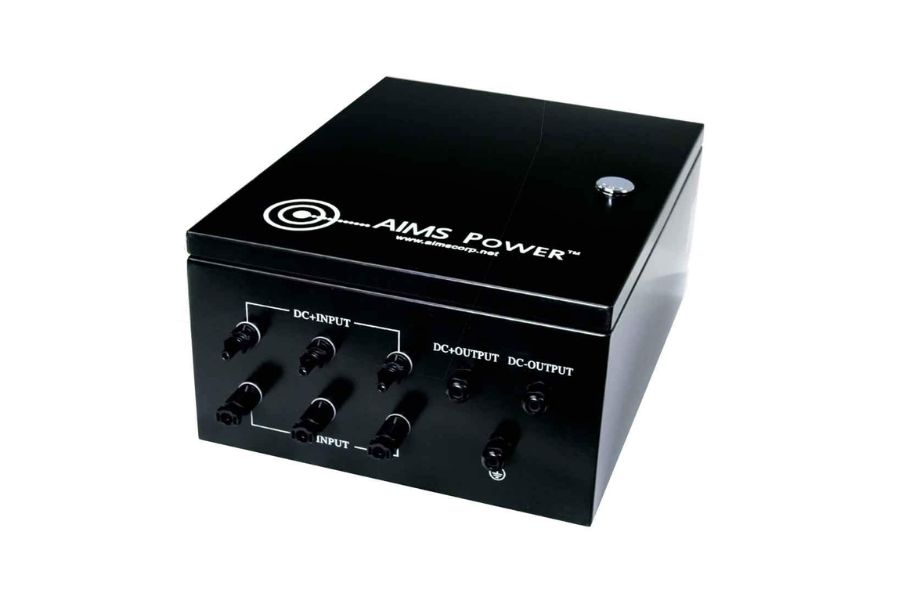
For a combiner box crafted for up to 3 strings, the AIMS COM3IN60A sure packs a lot of power. But beyond power, it offers considerable weather resistance, multiple safety features, and easy installation.
The AIMS COM3IN60A can handle an input voltage of up to 200 volts. While this value falls short of the Eco-Worthy Box and the ECO LLC 4 Box, it is pretty impressive. This combiner box supports up to 25 amps for each array but a maximum of 60 amps for all three. The total maximum input voltage supported by the AIMS COM3IN60A matches that of the Eco-Worthy Box. However, its input voltage supported per array is higher – even more than other combiner boxes on the list.
This combiner box has an overall DC input rating of 1000 volts – the same as the Eco-Worthy Box and the ECO LLC 4 Box.
Apart from the above, the AIMS combiner box is chock-full of safety components. The 125-amp resettable output breaker interrupts the flow of current from the solar panel to the inverter. Then there is the diode protection, which blocks the back feed of power. This combiner box also has lightning and ground protection. So, you are well-covered.
The AIMS combiner box encloses are tamper-proof and rated IP65 – the same as the Eco-Worthy Box. An IP65 rating means the box will resist normal jet streams of water, such as rain. It also means that it is totally dustproof.
The AIMS combiner box comes with multiple mounting options to make putting it in easy. You may use racking, support bracket, or plinth.
While the AIMS combiner box is a top product, its string support does not match the Eco-Worthy Box and the ECO LLC 4 Box. Also, its water resistance is trumped by that of the ENZPOWER IP66 Solar System Box.
Pros
- The maximum input voltage supported per array is pretty high – more than the other products on the list.
- It comes with multiple safety features.
- It’s waterproof – the same water resistance as the Eco-Worthy Box and the ECO LLC 4 Box.
- It comes with multiple mounting options for flexible installation.
Cons
- The number of strings supported could be higher.
FAQs
What Is a Solar Combiner Box?

A solar combiner box consolidates the strings from a PV array before connecting them to the inverter or charge controller. A combiner box connects each panel string to a fuse terminal. Then the output of the fuse terminal of each string connects to a single output cable from the combiner box. The single output cable, in turn, connects to the charge controller or inverter.
Summarized above is the primary role of a combiner box. But beyond that, a combiner box may also function as monitoring equipment, a surge protector, disconnect switches, a lightning protector, and a rapid shutdown switch.
Besides the above, a solar combiner box may also come with anti-backflow diodes. With this component, you would not have to worry about the battery losing charge to the solar panels through the back feed.
Do I Need One?
Solar combiner boxes are vital for solar panel systems with several solar strings. But with projects that have just a few strings (particularly home solar projects), you do not necessarily need a combiner box.
If you do not have up to 3-panel strings in your solar power system, you may choose not to get a combiner box. However, combiner boxes have many benefits, even with less than 3 strings.
For one, a combiner box makes the installation process easier. Solar combiner boxes merge all the cables that would have connected the panel strings to the inverter. This way, the installation process will only require a few cables. You will spend less with fewer cables, and the connections are more direct.
So, imagine you have 12 solar panels. To connect them to your inverter or charge controller directly, you will need about 24 pieces of wires. Then depending on how far the panel is from the inverter, you may need extra lengths of wires.
Of course, if you carefully think through it, running 24 long pieces of wires from the panels to the inverter will be a complex process. With a combiner box, you would not have to go through a process that complicated. All 24 wires from the panels meet inside the combiner box, which is installed proximal to them. Then, their outputs are transferred to the inverter through 2 pieces of wires. So, there would be no numerous or long pieces of wires.
Apart from that, combiner boxes offer extra protection to your PV system. They come with surge protectors, which protect your inverter from overcurrent and overload. Then they may also come with anti-backflow diodes, which ensure that the battery does not lose charge over time.
Beyond that, combiner boxes can also improve the efficiency of an off-grid system. One such way of doing this is by reducing the length and number of cables you need to connect the panels to the inverter. The off-grid system will experience lower current resistance with shorter and fewer cables. Consequently, more of the power generated by the panels is fed to the inverter.
One good thing about PV combiner boxes is that they typically last as long as the solar panel system. As long as they are installed and maintained properly, you will not have to replace them during the life cycle of the PV system.
How Do You Connect Solar Panels to a Combiner Box?
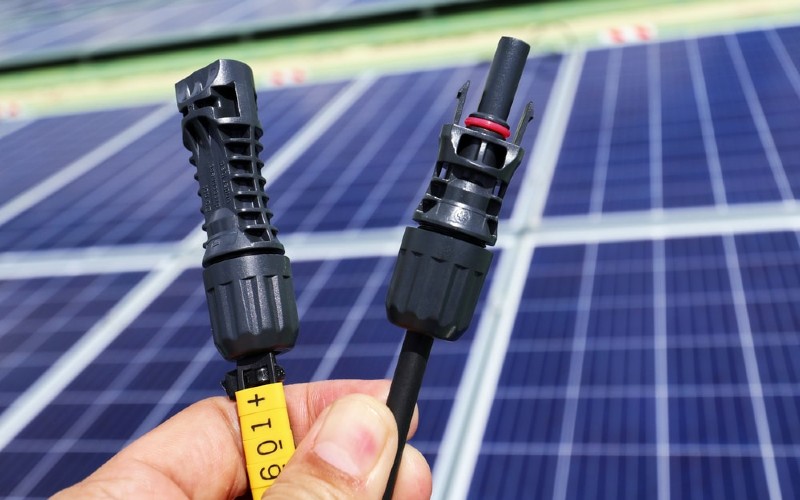
When connecting solar panels to a combiner box, you have to decide if you will string in series or parallel.
If you string in series, the total output voltage of the solar panels equals the sum of the voltage of the individual panels. However, the total current output will remain the average current of the panels.
But if you string in parallel, the total output voltage of the panels will equal each panel’s voltage. However, the total current output will increase with each additional panel.
How To Connect Solar Panel String in Series to a Combiner Box?
- If you opt to string in series, you must connect one panel’s positive terminal to the next’s negative terminal.
- Once you have done this to all the panels, you will end up with one unconnected positive and negative wire.
- Connect these unconnected wires to the combiner box through the DC input on the box.
- Then, you are done connecting the solar panels to the combiner box.
When connecting the wires from the solar array to the combiner box, ensure you connect them properly. The positive wire should go into the positive terminal of the DC input. Then, the negative wire should go into the negative terminal. Failure to connect the wires to the right terminal will cause a short circuit.
How To Connect Solar Panel String in Parallel to a Combiner Box?
- Connect each panel’s positive wires to a single wire if you connect in parallel. Then, connect all the negative wires to another single wire.
- Run the single positive and negative wires to the combiner box.
- Then, pass them through the positive and negative terminals of the DC input accordingly.
- Then, you are done connecting the parallel solar panel strings to the combiner box.
When connecting solar strings in parallel, you may create unit series strings first. Afterward, you may connect each of the series strings in parallel.
So, if you have 24 panels, you may create 6 series strings of 4 panels each. Then you may then connect these 6 series in parallel. This way, you can get the higher voltage and higher current benefits of series and parallel connection to an extent.
How Do You Make a Combiner Box?
To make a combiner box by yourself, you will need the following items:
- A plastic electric box (with about 1-inch opening on both ends)
- A ground bar
- Superglue
Once you have the materials listed above, follow these steps:
- Cut the ground bar into 2 equal pieces.
- Place the ground bars side by side at the bottom of the electric box and parallel to the openings. Leave a space of about 0.5 to 1 inch between the ground bars.
- Then, glue the ground bars to the electric box.
This combiner box will perform the basic role of a combiner box. It will combine wires from multiple solar panel strings and then connect to a charge controller or an inverter through a single pair of wires. However, it will not offer surge protection or serve as a monitoring device or a rapid shutdown switch.
When getting the ground bar, ensure you get one with enough holes for the strings. For instance, if you have 4 strings, you will need 8 holes. So, a ground bar with at least 8 holes would do.
Final Thoughts
The Eco-Worthy Box stands out as our best combiner box because of its high capacity, high water resistance, multiple safety features, wide operating temperature range, and high string input support. No other combiner box on our list of best combiner boxes came with many top features in one product.
When choosing a combiner box amongst many options, you should prioritize safety first. You do not want a combiner box that leaves you at risk of an electric shock. You also do not want one that will leave the rest of your PV system prone to short circuits, arc faults, power surges, and lightning strikes. So, ensure you get one with sufficient safety components.
Apart from that, the best combiner boxes typically support multiple strings, and they have the capacity to match high-voltage inverters. But ultimately, the capacity of your combiner box depends on your PV system. Finally, in your search for the best combiner box, look out for weather-resistant, easy-to-install, and wide operating temperature ranges.








